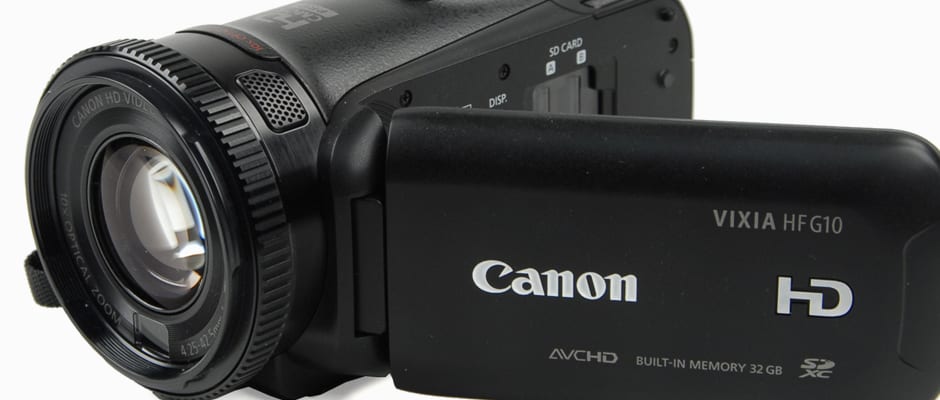Pros
Cons
Introduction
Front
{{section_header}}{{section.name}}{{/section_header}}
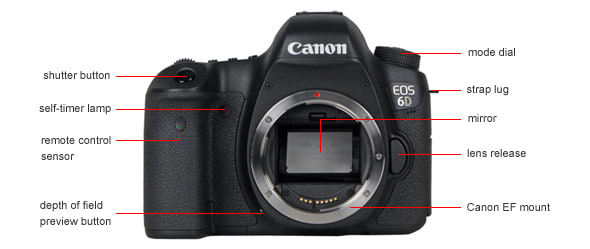
Back
{{section_header}}{{section.name}}{{/section_header}}
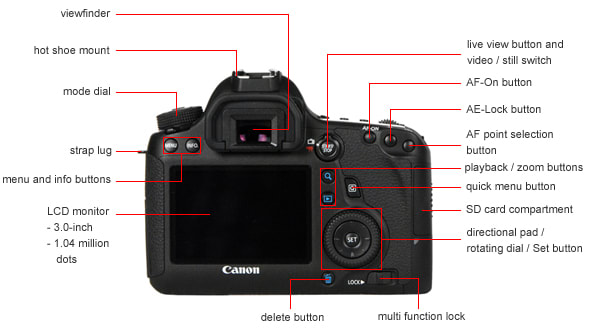
Left
{{section_header}}{{section.name}}{{/section_header}}
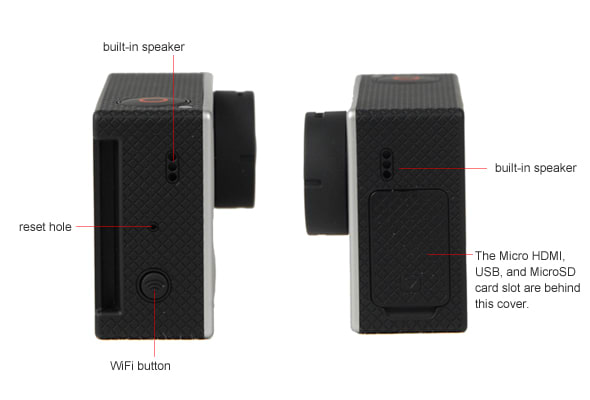
Right
{{section_header}}{{section.name}}{{/section_header}}
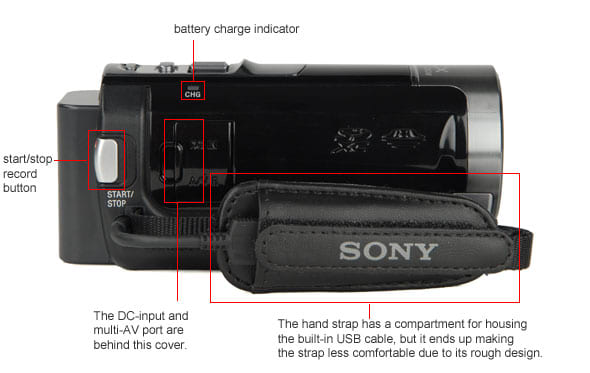
Top
{{section_header}}{{section.name}}{{/section_header}}
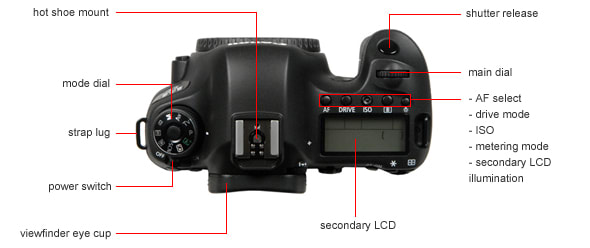
Bottom
{{section_header}}{{section.name}}{{/section_header}}

In the Box
The Canon HF G10 comes with the following accessories:
- Lens Hood
- Battery Pack (BP-808)
- Power Adapter (CA-570)
- Remote Control
- Stylus Pen (not pictured)
- USB Cable
- AV Cable
- Mini HDMI Cable
- Instruction Manual (not pictured)
- Software Discs (not pictured)
Color
{{section_header}}{{section.name}}{{/section_header}}
The new Canon HF G10 produced excellent results in our color accuracy test and we were pleased to see the camcorder offered significant improvement over last year's HF S21. The G10 had a low color error of 3.22 and a saturation level that fell just under 100%. These are top-notch results for a consumer camcorder, although the Panasonic HDC-TM700 did fair a bit better in this test. More on how we test color.
The map above is a diagram of the color error. The length and direction of each line indicates how the camera processed each particular color while capturing video.
The Canon Vixia HF G10 produced a color error of 3.22 and a saturation level of 98.21% in our bright light color testing.
In addition to its good color accuracy in auto mode, the HF G10 also has a few manual color controls that offer adjustments to color depth, contrast, sharpness and brightness (each with a -2 to +2 adjustment range). Examples of the color depth and contrast adjustments can be seen below. If you don't want to adjust these things manually, the HF G10 also has a set of Cinema-Look Filters, a few of which alter the color performance on the camcorder. These filters include options called Vivid, Dream, Cool, Nostalgic, Sepia, Old Movies, Memory, and Dramatic Black & White.
On the surface, the colors produced by the HF G10 don't look all that much different to what we see from the HF S21. Looking closer, though, you'll see the G10 has a better contrast range and its colors are deeper and more vibrant. You can see this in the large comparison images below, as well as the close-up color comparisons that follow. The Panasonic HDC-TM700 produced equally vivid colors (saturation level of 98%) to the Canon HF G10, while both the HF S21 and Sony HDR-CX550V had saturation levels below 90% (88% for the Sony, 84% for the HF S21).


Low Light Color
{{section_header}}{{section.name}}{{/section_header}}
Continuing with its strong low light performance, the Canon HF G10 produced colors in our low light test with very good accuracy. The camcorder managed a color error of 3.89 and a saturation level of 76.73%. Both of these numbers are a bit worse than the G10's bright light performance, but they are still well ahead of the competition (particularly last year's HF S21). More on how we test low light color.
The map above is a diagram of the color error. The length and direction of each line indicates how the camera processed each particular color while capturing video.
As we did with our low light sensitivity test, we also tested the HF G10 in color accuracy using its alternate frame rates. The alternate frame rates did allow the camcorder to produce a brighter image, which resulted in higher saturation levels, but the color accuracy didn't increase significantly (as you can see from the chart below). We saw the same amount of improvement when we shot with the camcorder using less zoom and an aperture of around f/2.
The HF G10 doesn't have a much brighter image than the competition, but its colors are very strong (and it is a bit brighter than the HF S21 overall). What the camcorder's excellent sensitivity score tells us is that its image doesn't get much darker than what you see below—until the light levels get extremely dim. Essentially, the HF G10 is able to produce a usable, consistent image until there is very little light in your shooting environment.
Noise
{{section_header}}{{section.name}}{{/section_header}}
Noise levels were just under 0.6% in our bright light testing with the HF G10. Much like we saw in our color accuracy test, this is a better performance than the Canon HF S21 registered (0.75% noise). None of the camcorders below did a "bad" job in this test, and we rarely see a sub par noise performance from a high-end HD camcorder in bright light. More on how we test noise.
Since none of the camcorders shown above have a terrific problem with noise, let's take a look at the sharpness each camcorder is capable of. The crops above do a great job illustrating sharpness, and you can see that the HF G10 and the Sony HDR-CX550V have images that look a bit softer than the Canon HF S21. The Panasonic HDC-TM700 has the most detailed image by far, and that is a direct result of the camcorder's pristine 1080/60p record mode that utilizes a very high recording bitrate.
Low Light Sensitivity
{{section_header}}{{section.name}}{{/section_header}}
No consumer camcorder has done as well on our low light sensitivity test as the Canon HF G10. It seems Canon was absolutely correct in their tinkering with the sensor system on the G10—the smaller amount of pixels vastly improved low light performance over last year's HF S21. In our testing, the HF G10 needed just 5 lux of light to hit 50 IRE on our waveform monitor. This is an improvement of 9 lux over the HF S21 and it is 6 lux better than the Panasonic HDC-TM700, which we consider to be an excellent low light model. More on how we test low light sensitivity.
Using the HF G10's alternate frame rates (PF24, PF30, and 24p) enable the camcorder to produce a viable image with even less light. All three of the alternate frame rates needed just 2 lux of light to hit 50 IRE on our waveform monitor. These are unprecedented and impressive results. We also tested the Canon HF G10 using its widest aperture setting to see how much this improved low light sensitivity (this required using no optical zoom with the camcorder). Using its f/1.8 aperture, the HF G10 needed 3 lux of light to reach our testing benchmark. Needless to say, the HF G10 fared exceedingly well in all shooting modes with our sensitivity test, which is something we cannot say about many high-end HD camcorders.

Low Light Noise
{{section_header}}{{section.name}}{{/section_header}}
Honestly, we expected the HF G10 to do poorly in this test, but the camcorder surprised us with another impeccable performance. In its regular shooting mode, the HF G10 averaged 0.81% noise. This is a whole lot less noise than the Canon HF S21 produced in low light, and it is consistent with some of the best low light noise scores we've seen on a consumer camcorder. More on how we test low light noise.
Strangely, the 24p and PF30 frame rate options on the HF G10 did not help the camcorder in this test. We measured a slightly higher noise level on the G10 when recording with its 24p mode (around 1.0%), and we saw a similar amount of noise when we opened the aperture up a bit on the camcorder (to around f/2.0). As you can see from the crops above, the HF G10 doesn't have the sharpest image in low light, but it sure isn't bad (we'd say its at least as sharp as the Sony CX550V). Besides, the lack of noise and overall clean image from the HF G10 is enough to overlook a slightly diminished sharpness.
Low Light Color
{{section_header}}{{section.name}}{{/section_header}}
Continuing with its strong low light performance, the Canon HF G10 produced colors in our low light test with very good accuracy. The camcorder managed a color error of 3.89 and a saturation level of 76.73%. Both of these numbers are a bit worse than the G10's bright light performance, but they are still well ahead of the competition (particularly last year's HF S21). More on how we test low light color.
As we did with our low light sensitivity test, we also tested the HF G10 in color accuracy using its alternate frame rates. The alternate frame rates did allow the camcorder to produce a brighter image, which resulted in higher saturation levels, but the color accuracy didn't increase significantly (as you can see from the chart below). We saw the same amount of improvement when we shot with the camcorder using less zoom and an aperture of around f/2.
As you can see from the images below, the HF G10 doesn't have a much brighter image than the competition, but its colors are very strong (and it is a bit brighter than the HF S21 overall). What the camcorder's excellent sensitivity score tells us is that its image doesn't get much darker than what you see below—until the light levels get extremely dim. Essentially, the HF G10 is able to produce a usable, consistent image until there is very little light in your shooting environment.
Motion
{{section_header}}{{section.name}}{{/section_header}}
Like the previous Canon models, the HF G10 handled our motion test quite well, and it earned plenty of bonus points for its extra frame rates. In addition to recording regular 60i video, the HF G10 also has PF30, PF24, and a native 24p frame rate for HD video recording. The only frame rate the camcorder is lacking that we'd like to see is a 1080/60p mode, which is found on the Panasonic HDC-TM700 as well as new 2011 models from Sony (like the HDR-CX700V). More on how we test motion.
There wasn’t much artifacting in the HF G10’s motion image, and the video produced by the camcorder was very smooth. The only problem we noticed was some slight blur on the rotating pinwheels in our test. Other than that, the HF G10’s video looked as good as the best motion performers we’ve seen. It’s video wasn’t quite as smooth as Panasonic’s 1080/60p mode on the TM700, but it was close.

Video Sharpness (11.32)
{{section_header}}{{section.name}}{{/section_header}}
Sharpness was an area where the HF G10 couldn't quite match the results of its predecessor, the HF S21. However, even though Canon reduced the pixel count significantly on the HF G10, the camcorder only lost a bit of sharpness compared to its predecessor. We measured the sharpness levels on the G10 at 850 lw/ph horizontal and 600 lw/ph vertical. These numbers aren't too shabby, particularly with all the image sensor tinkering that Canon initiated on the HF G10. This is very good news for Canon, and, as you'll see in the next section, the HF G10 offers a superb low light performance in exchange for its slight drop in sharpness. More on how we test video sharpness.

Stabilization (6.26)
The Canon HF G10 put up very similar numbers to its predecessor in our stabilization test. This shouldn’t be much of a surprise, as the HF G10 is equipped with the same optical image stabilization options as the HF S21 before it. The hard numbers for those who are interested: the G10 reduced 42% of the shake in our low shake test and 32% of the shake in our high shake test when using its optical image stabilization.
The G10 does have a dynamic stabilization mode and a powered IS setting, but neither of them helped out too much in our low shake test. Dynamic mode reduced 37% of the shake and powered IS reduced 44% in the low shake test. Strangely, in the high shake test, the powered IS did a very bad job—reducing the shake by just 18%. What this tells us is that Canon’s basic OIS should get the job done fine. You don’t really have to use the other modes unless you notice them helping for your specific shooting situation. More on how we test stabilization.
Testing Samples
{{section_header}}{{section.name}}{{/section_header}}
Ease of Use (6.50)
{{section_header}}{{section.name}}{{/section_header}}
The HF G10 is not geared towards beginners, let's make that clear. It is more like a prosumer or professional product wrapped up into a compact package. The camcorder has a lot of features, particularly advanced features, than your average novice user would be most likely to ignore. Despite all this, the G10's auto mode is simple and easy to use—it's really no different than the auto mode on any other Canon camcorder. Pros may complain that the camcorder feels constricted and awkward due to its cramped design, but Canon does attempt to offer customization (with assignable buttons) and a professional feel with the large manual focus ring.
Canon produces some of the best instruction manuals in the business, and, while the HF G10 is a complex camcorder, the manual should help you figure out everything you know. The camcorder itself doesn't have any tool tips or info boxes built into the menu system, though, and that is something we'd like to see.
The menu system on the HF G10 can be daunting, specifically because the camcorder is, well, loaded with controls. There are so many options crammed into the little camcorder that the menu looks flooded with features. It's not a huge deal, and we're sure any dedicated user will get the hang of the menu system, but it is definitely confusing at first look. Canon doesn't help by giving the menu options very good labels or icons. Some of them are difficult to decipher for this reason, so you'll probably need a bit of instruction manual perusing before you master the menus on the G10.
There's two menus on the HF G10. When you press the function button on the LCD it brings you to a screen full of small icons (the confusing screen we talked about above). These icons and buttons represent all sorts of features on the camcorder that are meant to be quickly accessible, as well as accessible during recording (for some of them). The full menu, which has the traditional scrolling list design, can be viewed by clicking on the menu button that sits at the upper left after you open the function menu.
Auto Mode (10.47)
{{section_header}}{{section.name}}{{/section_header}}
Get ready for a lot of information in this section, as the HF G10 is absolutely loaded with auto controls, manual controls, and key features. It has nearly all of the auto controls that you'd find on the Canon HF S21, plus a bunch more. Canon expanded the Smart Auto scene selection to include more scene modes (38 different modes, to be exact), added a new medium autofocus speed, and employed a boatload of zoom speed controls.
The AF/AE tracking feature is still present, as are single "touch" options for focus and exposure. All controls on the G10 can be manipulated with the LCD touchscreen and most of them can be set with a small, rotatable dial on the back of the camcorder. This small dial is one thing we hate about the HF G10. We don't like the way it feels, nor do we like the roundabout manner in which it works.
The auto controls on the HF G10 function very well, although we did notice the auto exposure wasn't always smooth when moving from light to dark scenes (we saw this issue with the HF S21 too). With the camcorder set in its dedicated auto mode you cannot access many controls: only zoom, decoration, story creator, and video snapshot are available. You can also take still photos in auto mode and the camcorder's stabilization system is automatically engaged.
The Cinema mode on the HF G10, which we talk about in more detail later in this section, is like an advanced auto mode. You pick a certain filter (there's nine options) and you can adjust basic controls to set their look and style. You still have options for controlling most of the features that you find in Manual mode, but a few are not available in Cinema mode.
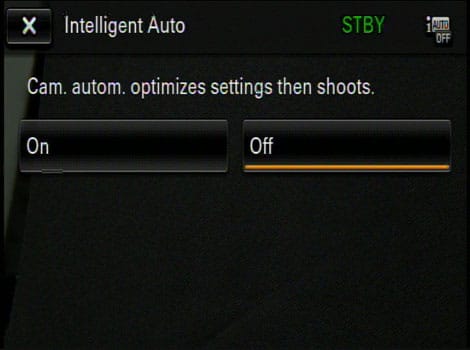
The iAuto mode button is difficult to find, but when you do find it the option for turning on the mode looks like this.
Auto Controls
{{section_header}}{{section.name}}{{/section_header}}
Exposure - There aren't quite as many exposure controls on the G10 as there are focus controls, but there's still quite a few. You can set the exposure in 1/4 EV increments from -3 to +3 values. There's also a zebra pattern setting to keep an eye on overexposure, an auto exposure lock feature (AE Lock), touch exposure with the touchscreen, and a waveform monitor.
We love all these options for basic exposure adjustment, but we don't like the implementation of the rear-mounted control dial that can be used to set the exposure controls. The dial is small and not nearly as precise as the large lens ring that is dedicated to focus (nor is it as good as the control dial found on the Canon HF S21). You can set exposure by tapping touchscreen buttons as well, and we may actually prefer this method to the tiny, hard-to-reach control dial on the back.
Color & Image Controls
Image Effects - There's no preset color modes in this setting anymore (presets have now taken the form of Cinema Modes -- see below), but the HF G10 does have four image effect options that can manually be increased or decreased. These include color depth, contrast, sharpness, and brightness. All of them have adjustment ranges from -2 to +2.
ND Filter - We talked about the ND filters a bit in the aperture section further up on this page. "ND" stands for Neutral Density and it essentially cuts the intensity of all light equally when activated. So a 1/8 ND filter would cut 1/8 of the light. ND filters are activated by adjusting the aperture.
x.v. Color - Allows the camcorder to record using the xvYCC expanded color gamut. You'll only be able to see the expanded colors if you view the footage on a compatible television.
Cinema Filters - This is one of the more interesting new features on the HF G10. There are 9 Cinema-Look filters on the camcorder when you switch over to Cinema mode. All of these filters (other than basic Cinema mode) have intensity levels of low, medium, and high. Regular Cinema mode allows you to set color depth (±2), contrast (±2), softening filter, and key lighting. The Cinema Filters include: Cool, Dramatic Black and White, Dream, Memory, Nostalgic, Old Movie, Sepia, and Vivid.
Zebra Pattern - Displays striped patterns on the screen to show areas of the frame that are overexposed. Can be set to 70% or 100% sensitivity levels and this option can be selected during aperture or shutter speed adjustment.
Handling (7.35)
{{section_header}}{{section.name}}{{/section_header}}
The shape and size of the HF G10 isn't much different than the Canon HF S21. It has a round shape and it is all lens up front (we're talking large lens). The handstrap is thick, padded, and one of the best in the business for a consumer camcorder. Canon usually does well in the handstrap department. The LCD is expansive and pristine and its flat design without a raised bezel is both stylish and functional. The touchscreen has a good feel to it—somewhat like an iPhone or iPod touch—although the touchscreen interface can still be frustrating when there are a lot of onscreen buttons displayed.
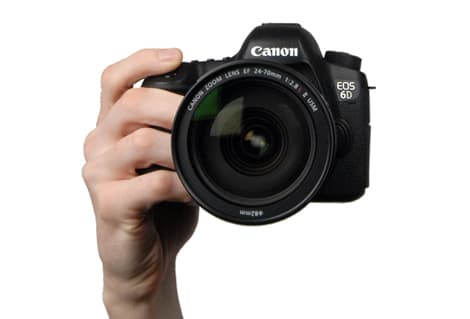
The HF G10 is big, but it feels good in your hand.
The big difference with the G10 is its new lens ring, the accompaniment of a detachable lens hood, and a new control dial on the back of the camcorder. The lens ring is well-built and feels great, but it has one bothersome issue. Since the lens on the G10 doesn't jut out from the body of the camcorder, using the lens ring can result in your fingers bumping the edge of the LCD panel if it is open (particularly if it is tilted).
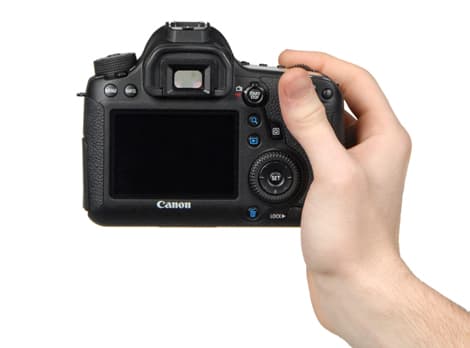
The control dial on the back is one of the G10's weaknesses in terms of handling.
More of a problem is the poorly-designed control dial on the back of the camcorder. We don't like where it's placed and we don't like the roundabout way you have to set up controls to be manipulated by it. We wish Canon would have allowed the lens ring to control other functions in addition to focus, but that's not the case (the ring does focus only). Shutter speed, aperture, gain, and exposure can all be set with the rear-mounted control dial, but you must first select the manual options for these controls (other than exposure) in the G10's menu system. This means the dial cannot be used on the fly with the LCD panel closed. It's a confusing system, and it is probably something Canon could have simplified. Still, we like the amount of control the HF G10 offers—that is something we cannot ignore.
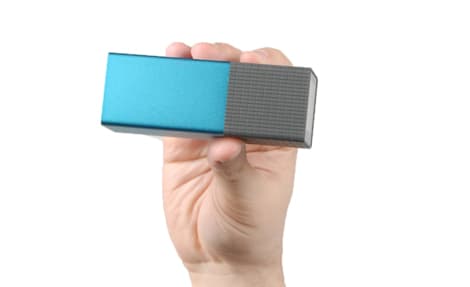
The large LCD displays video beautifully, and the camcorder has one of the better touchscreens on the market.
The biggest advantage the HF G10 holds over other models in terms of handling is its customization and control. The camcorder has two customizable buttons on the LCD panel, and you can adjust far more controls than you can on most consumer camcorders. The G10 has professional-grade tools like a waveform monitor, zebra stripes, and advanced audio controls as well. The method for adjusting said controls isn't always great, as we pointed out with the criticism of the control dial, but the fact that the HF G10 includes these options is a wonderful asset. This is a prosumer camcorder in a consumer cam body.
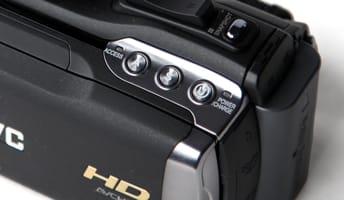
These dedicated buttons give you quick access to aperture and shutter speed controls.
There's no built-in lens cover for the camcorder, but it comes with a large removable one.
Portability (4.51)
{{section_header}}{{section.name}}{{/section_header}}
The HF G10 is among the largest consumer camcorders on the market, and it wights about 590g fully loaded with its battery pack and lens hood. This is a good 70g heavier than the Canon HF S21 and over 100g heavier than the 2010 flagship models from Panasonic and Sony (see table below).
But... the HF G10 isn't meant to be a slip-in-your pocket toy-cam. It's designed to be a powerful camcorder loaded with pro-grade features. It has a giant lens, two memory card slots, a viewfinder, a big LCD, and lots of connectivity options. Even with all this, it is still far smaller than your average pro camcorder, yet it has nearly all the controls and features of a pro model.
Basically, the HF G10 is about as small as you can get for a camcorder loaded with as many features as it has. Sure, it's a good deal bigger than certain other flagship models (particularly Panasonics), but when you're choosing a high-end product sometimes a little bigger is better. The bulk of the HF G10 offers a sense of professionalism and sophistication in lieu of a more compact and lighter design.

Battery Life (5.70)
{{section_header}}{{section.name}}{{/section_header}}
As far as flagship camcorders go, the Canon HF G10 did quite well in our battery life test. The camcorder lasted for 114 minutes of continual recording, which is more than a half hour longer than the Canon HF S21 lasted. We applaud this improvement by Canon, as the company went from one of the worst battery life performers (on its flagship model) in 2010, to one of the best. It's battery life wasn't hugely better than what Sony and Panasonic were capable of, but the improvement over the dismal 80-minute performance by the HF S21 is what impresses us. More on how we test battery life.
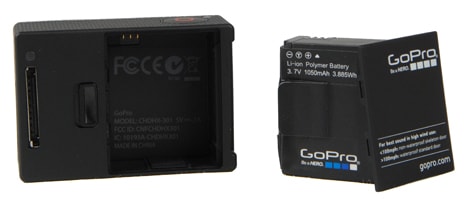
The provided battery pack did well in our testing.
LCD & Viewfinder (12.54)
{{section_header}}{{section.name}}{{/section_header}}
Canon didn't appear to change the LCD on the HF G10, as it is the same size and has the same resolution as last year's HF S21. Video looks great on the sizable 3.5-inch screen, but we still had a bit of trouble with the touchscreen interface (despite the large surface area). This is more of a critique of Canon's menu system than anything else, and the fact that the HF G10 has a lot of onscreen buttons and menu options that you have to deal with using the touchscreen interface.

The 3.5-inch LCD is both stylish and functional.
On the back of the HF G10 is a small electronic viewfinder (EVF). The viewfinder has little in the way of an eyepiece, but it does have the ability to extend (about a half inch) from the camcorder and it has a diopter adjustment slider. We found the viewfinder was difficult to lock in place after it was extended fully, which meant it was sliding around at times when we didn't want it to.
We wish the viewfinder would pivot up and down in addition to extending out from the camcorder.
Stabilization (6.26)
{{section_header}}{{section.name}}{{/section_header}}
The Canon HF G10 put up very similar numbers to its predecessor in our stabilization test. This shouldn't be much of a surprise, as the HF G10 is equipped with the same optical image stabilization options as the HF S21 before it. The hard numbers for those who are interested: the G10 reduced 42% of the shake in our low shake test and 32% of the shake in our high shake test when using its optical image stabilization.
The G10 does have a dynamic stabilization mode and a powered IS setting, but neither of them helped out too much in our low shake test. Dynamic mode reduced 37% of the shake and powered IS reduced 44% in the low shake test. Strangely, in the high shake test, the powered IS did a very bad job—reducing the shake by just 18%. What this tells us is that Canon's basic OIS should get the job done fine. You don't really have to use the other modes unless you notice them helping for your specific shooting situation. More on how we test stabilization.
Miscellaneous Controls (22.00)
{{section_header}}{{section.name}}{{/section_header}}
Conversion Lens
When using a conversion lens (either tele or wide) with the HF G10, you can turn this setting on to optimize the autofocus and image stabilization settings to work in conjunction with the attached conversion lens.
Tele Macro
Hidden in the camcorder's onscreen zoom controls, a tele macro option automatically switches focus and zoom for up-close shooting.
Onscreen Markers
A variety of grid patterns can be displayed to assist with framing on the HF G10. This feature may be useless to home video shooters, but it is definitely a plus for pros.
Color Bars & Test Tone
Another feature that is likely to be ignored by non-professional users, Color Bars & Test Tone allow you to display... well, color bars and a test tone. You can use this for calibration, or for putting a marker on the beginning or end of your clip.
Auto Controls (10.47)
{{section_header}}{{section.name}}{{/section_header}}
Exposure - There aren't quite as many exposure controls on the G10 as there are focus controls, but there's still quite a few. You can set the exposure in 1/4 EV increments from -3 to +3 values. There's also a zebra pattern setting to keep an eye on overexposure, an auto exposure lock feature (AE Lock), touch exposure with the touchscreen, and a waveform monitor.
We love all these options for basic exposure adjustment, but we don't like the implementation of the rear-mounted control dial that can be used to set the exposure controls. The dial is small and not nearly as precise as the large lens ring that is dedicated to focus (nor is it as good as the control dial found on the Canon HF S21). You can set exposure by tapping touchscreen buttons as well, and we may actually prefer this method to the tiny, hard-to-reach control dial on the back.
Color & Image Controls
Image Effects - There's no preset color modes in this setting anymore (presets have now taken the form of Cinema Modes -- see below), but the HF G10 does have four image effect options that can manually be increased or decreased. These include color depth, contrast, sharpness, and brightness. All of them have adjustment ranges from -2 to +2.
ND Filter - We talked about the ND filters a bit in the aperture section further up on this page. "ND" stands for Neutral Density and it essentially cuts the intensity of all light equally when activated. So a 1/8 ND filter would cut 1/8 of the light. ND filters are activated by adjusting the aperture.
x.v. Color - Allows the camcorder to record using the xvYCC expanded color gamut. You'll only be able to see the expanded colors if you view the footage on a compatible television.
Cinema Filters - This is one of the more interesting new features on the HF G10. There are 9 Cinema-Look filters on the camcorder when you switch over to Cinema mode. All of these filters (other than basic Cinema mode) have intensity levels of low, medium, and high. Regular Cinema mode allows you to set color depth (±2), contrast (±2), softening filter, and key lighting. The Cinema Filters include: Cool, Dramatic Black and White, Dream, Memory, Nostalgic, Old Movie, Sepia, and Vivid.
Zebra Pattern - Displays striped patterns on the screen to show areas of the frame that are overexposed. Can be set to 70% or 100% sensitivity levels and this option can be selected during aperture or shutter speed adjustment.
Audio Controls (7.00)
{{section_header}}{{section.name}}{{/section_header}}
The HF G10 has some nifty audio features that are usually reserved for professional camcorders. Some of these controls include frequency response and microphone directionality control with the built-in mic, as well as audio mix options with the external mic jack. There's a wind cut feature, a microphone attenuator, and manual audio level adjustment as well.
The frequency response controls allow you to boost or cut the low frequency range, boost the mid frequency range, or boost both frequency ranges. The mic directionality controls can be set to mono, normal, wide, or zoom. Both of these features are something Canon has not included on its consumer camcorders before, so it is a pleasant addition that should make audiophiles happy.
The built-in mic records 2-channel stereo and the placement of the mic is decent (it's on the top of the camcorder). You may accidentally rub against the mic when you use the lens ring, but you should be able to keep away if you're careful. The external mic jack is unprotected on the right side of the camcorder, which is one of the few gripes we have with the G10's audio features.
Editing (7.00)
{{section_header}}{{section.name}}{{/section_header}}
The HF G10 comes with Pixela Video Browser, but we couldn't determine if the software has been updated over last year's version. Canon was unable to furnish us with the software expected to ship with the HF G10, so, for now, you can read about the previous version of Pixela Video Browser that came with last year's models by checking out our article article: "Video Editing Software For Your Camcorder. For an overview of the software that ships with this and other camcorders, see our article: Video Editing Software For Your Camcorder{{product.brand.name}}-Included-Software.htm.
As for internal editing components, the HF G10 actually has quite a few. There's a decoration function that allows you to add titles, displays, or even draw on your recorded image (by dragging your finger all over the LCD). In addition to this, there's an HD to SD down-conversion option that you can use as long as you have a memory card inserted in the camcorder.
Compression (8.00)
{{section_header}}{{section.name}}{{/section_header}}
Like the majority of HD camcorders these days, the HF G10 records video using AVCHD compression. The camcorder cannot record standard definition video, but it does have an HD-SD down-conversion feature that can be used to create standard definition videos out of your HD clips (while preserving the original content). In the table below, you can see the five quality settings available on the HF G10, two of which allow for Full HD 1920 x 1080 recording. The other three record 1440 x 1080 HD video that is stretched into a 1920 x 1080 image during playback. Read more about the advantages and disadvantages of various high definition compression types.

Media (9.77)
{{section_header}}{{section.name}}{{/section_header}}
The HF G10 comes loaded with 32GB of internal flash memory along with its dual memory card slots that work with SD, SDHC, and SDXC cards. 32GB of internal memory is nothing to sneeze at, but many flagship models offer double that amount. The fact that the G10 comes with two card slots does do a bit to remedy the media capacity situation, though, so we doubt capacity should be a problem for most users.
According to Canon, a single scene can be recorded for 12 hours. After 12 hours of recording, the HF G10 will automatically stop recording (for roughly three seconds) before starting a new clip. Read more about the advantages and disadvantages of various media types.
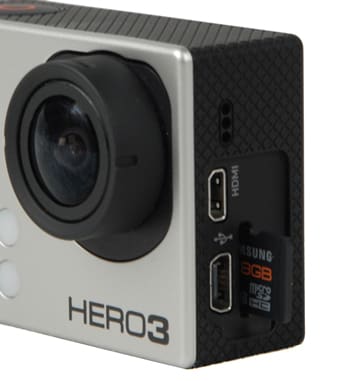
Still Features (8.45)
{{section_header}}{{section.name}}{{/section_header}}
Canon made the focus of the HF G10 on video recording, and that means still image controls take a back seat on the camcorder. You can still capture photos, but there's only one size option (1920 x 1080) and the camcorder has no dedicated still image mode. All the traditional options are there—simultaneous video/still capture, a continuous shot mode, and a self timer—but the G10 does not have a built-in flash.
Honestly, we don't think this is a big issue, and that's what Canon is banking on as well. The company thinks that most buyers of the HF G10 will be concerned about video quality first and foremost, hence they designed the camcorder to work best at capturing video rather than photos. Anyway, if you're serious about still image photography, you should be using a dedicated digital camera or DSLR rather than a camcorder in the first place.
Even though Canon did not emphasize still image performance on the HF G10, the camcorder was still able to put up some reasonable numbers in our testing. The G10 managed a color error of 5.21 and a saturation level of 110% in our still color tests, both of which are decent numbers, yet a bit worse than the camcorder earned in our video testing.
Noise levels weren't bad on the HF G10, but they were definitely higher than what the camcorder averaged in our bright light video test. The HF G10 registered 0.95% noise in this test, which is a middle of the road score in this category.
Since the HF G10 doesn't have a large pixel count, it shouldn't surprise anyone that the camcorder didn't put up strong numbers in this test. What is surprising, however, is that the camcorder didn't fall completely flat in still sharpness. In fact, it actually put up some so-so numbers. The camcorder measured a horizontal sharpness of 946 lw/ph with 8.4% oversharpening and a vertical sharpness of 828 lw/ph with 4.4% oversharpening. These numbers are clearly worse than the competition, but that's all due to the HF G10's sensor design that puts video quality ahead of still image performance.
Lens & Imaging System
{{section_header}}{{section.name}}{{/section_header}}
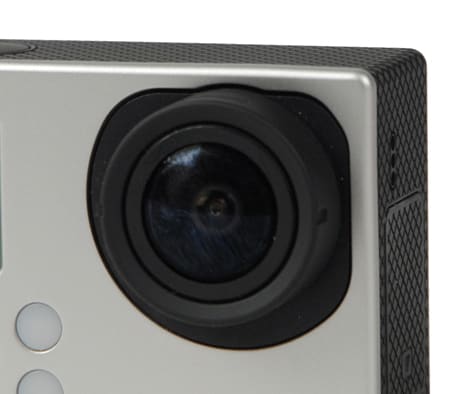
The Vixia HF G10 features a brand new lens and sensor system that have not previously been incorporated on a consumer camcorder from Canon. The lens is similar to what we saw on last year's HF S21 (same max aperture, 10x optical zoom, and filter diameter), but it has a slightly different focal range. The sensor, however, is very different from what Canon employed on last year's models. It's still a CMOS imager, but the size is just 1/3 of an inch with a pixel count of 2.37 megapixels.
This pixel count is a significant drop from what Canon offered on the HF S21. The reason? Canon feels that the high pixel count does not improve video performance, but is really only helpful for capturing still images. Since the HF G10 is a high-end camcorder, the still features aren't nearly as important as good video quality. This 1/3-inch CMOS is the same CMOS Canon uses in its professional camcorders, so that should give you an idea of what the company is thinking with this switch.

LCD & Viewfinder (12.54)
{{section_header}}{{section.name}}{{/section_header}}
Canon didn't appear to change the LCD on the HF G10, as it is the same size and has the same resolution as last year's HF S21. Video looks great on the sizable 3.5-inch screen, but we still had a bit of trouble with the touchscreen interface (despite the large surface area). This is more of a critique of Canon's menu system than anything else, and the fact that the HF G10 has a lot of onscreen buttons and menu options that you have to deal with using the touchscreen interface.

On the back of the HF G10 is a small electronic viewfinder (EVF). The viewfinder has little in the way of an eyepiece, but it does have the ability to extend (about a half inch) from the camcorder and it has a diopter adjustment slider. We found the viewfinder was difficult to lock in place after it was extended fully, which meant it was sliding around at times when we didn't want it to.
Connectivity (7.88)
{{section_header}}{{section.name}}{{/section_header}}
Being a flagship camcorder and a borderline-professional product, Canon smartly protects the ports and inputs on the HF G10 with strong covers and doors. Unfortunately, Canon did leave one important input uncovered—its 3.5mm external mic jack. The mic jack is located up front, on the right of the camcorder and just behind the lens. We like this placement, but we wish the port was better protected. Mic jacks like these are often vital for professional videographers.
Further back on the right side is a well-protected collection of ports that are located behind a hard plastic cover. Here you'll find the wired remote (LANC) port, an HDMI output, and a USB terminal. All three are labeled well, but they can be difficult to access due to their location behind the G10's large, plush hand strap (their location also prohibits you from being able to hold the camcorder comfortably while you have a cable running to any of these ports). On the upside, the wired remote port is an excellent addition, and its presence on consumer camcorders is rare these days. Another new perk is that Canon ships an HDMI cable with the HF G10, so you don't have to go out and buy an overpriced one from Best Buy.
Turning around to the left side of the camcorder you'll find a number of other ports inside the LCD cavity. A small slide-up door reveals the Component-out port and the AV-out terminal (which also doubles as a headphone output). To the upper right of these two video outputs are the dual memory card slots labeled "A" and "B". Both slots work with SD, SDHC, and SDXC memory cards, which means you can expand the recording capacity for the G10 quite a bit.
Probably the most important connectivity feature on the HF G10 is the camcorder's DC-input, which is aptly located right by the battery compartment on the back. This position keeps the power cable mostly out of the way if you ever need to wield the camcorder while it is plugged into a wall socket. The HF G10 also has a Canon-proprietary mini accessory shoe on the top (behind the zoom toggle). It's the same shoe Canon has used on its consumer camcorders for years.
Media (9.77)
{{section_header}}{{section.name}}{{/section_header}}
The HF G10 comes loaded with 32GB of internal flash memory along with its dual memory card slots that work with SD, SDHC, and SDXC cards. 32GB of internal memory is nothing to sneeze at, but many flagship models offer double that amount. The fact that the G10 comes with two card slots does do a bit to remedy the media capacity situation, though, so we doubt capacity should be a problem for most users.
According to Canon, a single scene can be recorded for 12 hours. After 12 hours of recording, the HF G10 will automatically stop recording (for roughly three seconds) before starting a new clip. Read more about the advantages and disadvantages of various media types.

Still Features (8.45)
{{section_header}}{{section.name}}{{/section_header}}
Canon made the focus of the HF G10 on video recording, and that means still image controls take a back seat on the camcorder. You can still capture photos, but there's only one size option (1920 x 1080) and the camcorder has no dedicated still image mode. All the traditional options are there—simultaneous video/still capture, a continuous shot mode, and a self timer—but the G10 does not have a built-in flash.
Honestly, we don't think this is a big issue, and that's what Canon is banking on as well. The company thinks that most buyers of the HF G10 will be concerned about video quality first and foremost, hence they designed the camcorder to work best at capturing video rather than photos. Anyway, if you're serious about still image photography, you should be using a dedicated digital camera or DSLR rather than a camcorder in the first place.
Even though Canon did not emphasize still image performance on the HF G10, the camcorder was still able to put up some reasonable numbers in our testing. The G10 managed a color error of 5.21 and a saturation level of 110% in our still color tests, both of which are decent numbers, yet a bit worse than the camcorder earned in our video testing.
Noise levels weren't bad on the HF G10, but they were definitely higher than what the camcorder averaged in our bright light video test. The HF G10 registered 0.95% noise in this test, which is a middle of the road score in this category.
Since the HF G10 doesn't have a large pixel count, it shouldn't surprise anyone that the camcorder didn't put up strong numbers in this test. What is surprising, however, is that the camcorder didn't fall completely flat in still sharpness. In fact, it actually put up some so-so numbers. The camcorder measured a horizontal sharpness of 946 lw/ph with 8.4% oversharpening and a vertical sharpness of 828 lw/ph with 4.4% oversharpening. These numbers are clearly worse than the competition, but that's all due to the HF G10's sensor design that puts video quality ahead of still image performance.
Other Features (4.50)
{{section_header}}{{section.name}}{{/section_header}}
Fader/Wipe
You can add faders or wipes (in a couple of different colors) to the beginning or end (or both) of your clips.
Video Snapshot
Canon has had this feature for a couple of years now and it hasn't changed all that much. With Video Snapshot you set a time limit to your recordings (2, 4, or 8 seconds) so that they all of your clips are roughly the same length. You can then group these clips together in playback mode, add music, and make your own little videos.
Story Creator
This new feature is a bit complicated to explain, but once you start to use it the system makes sense. In brief, Story Creator provides you with an outline or guide as to what shots you should collect in order to tell a specific "story." There are five story templates to choose from: Travel, Kids & Pets, Party, Ceremony, and Blog. Within each of these story templates are a number of scene ideas. For example, there's a "Setting up the venue" scene for the Party story and a "Snuggling - close-ups" scene for the Kids & Pets story. Many of the scenes give you advice as to how to get the shot (like saying "close-ups" or "wide-shots") and they all have a recommended time limit.
After you shoot a number of scenes with Story Creator, you can then view your stories in playback mode. Here, you can rearrange scenes, or view scenes as a labeled list. In playback mode, the stories function something like a more advanced (and better organized) playlist. There's also an Unrestricted story mode that does not provide you with any scene ideas or labels, but it still lets you rearrange any shots you took in playback mode.
Yes, Story Creator is very confusing to explain. It can also be difficult to work with, particularly if you're not fond of using the touchscreen interface on the LCD. Dedicated users, however, may find the function interesting and fun, and it definitely helps with clip organization. We're not sure a camcorder like the HF G10 is the best outlet for Story Creator, but we think the feature may be more popular on lower-end models.
Decoration
Want to add fun little stars or text to your video? Well, now you can with Canon's new "Decoration" feature. Honestly, we're surprised that Canon implemented this option on its flagship camcorder instead of trying it out on lower-end models first. Because that's really who this type of feature is meant for—beginners. Of course, it would be hilarious to watch a professional videographer add animated stamps to their video.
Pre Record
Canon has had this feature on its camcorders for a while, so at least some users should recognize it. Pre Record keeps a continual buffer of your video recording, so that as soon as you hit the record button the camcorder has already magically recorded 3 seconds of video. This feature will use up battery life, but it can be useful when you're trying hard not to miss any unrehearsed action sequences or exciting moments.
Canon HF S21 Comparison
Canon's decision to redesign the sensor using a smaller number of pixels for the HF G10 was definitely a good one. The camcorder featured vastly improved low light capabilities and its performance in bright light was nearly as strong as its predecessor, the HF S21. The only downside of the HF G10's new sensor was that the camcorder captured slightly less sharp video, and the fact that it cannot take high-resolution still images. These are minor setbacks, however, and the improved low light performance of the G10 makes these other issues trivial.
This is not to say the HF S21 is a bad camcorder in its own right. It put on strong performances in a number of our tests, and its design has the same professional sophistication that Canon puts forth with the HF G10. The HF G10, however, has more features and even better performance than its predecessor, and that makes it a better choice for pros or advanced users. The set of controls on the HF G10 is unprecedented in the consumer camcorder field, although we weren't crazy about the interface for adjusting certain functions (the rear-mounted control dial is not up to snuff).
If recording great video is your primary concern, the Canon HF G10 is the best new camcorder we've seen so far. It has much improved performance over Canon's previous Vixia camcorders and its control set is fantastic. If, for some reason, you require a camcorder that captures high-resolution still images, then the Canon HF G10 is not the model for you. This would be the only reason to settle with the Canon HF S21 instead.
Panasonic HDC-TM700 Comparison
The Canon HF G10 is the first camcorder to give the Panasonic HDC-TM700 a serious run for its money. Don't take this phrase to mean the HF G10 is a better bargain than the HDC-TM700—it's not—but it may be a better camcorder overall. Canon's new model outperformed the TM700 in our low light testing and in a number of our other performance tests as well, and that is saying something. Of course, the HF G10 does lack a 1080/60p record mode, so that is one feature where the HDC-TM700 holds an advantage.
In our overall scoring system, the Canon HF G10 earned a slight edge over the Panasonic HDC-TM700. The Panasonic had better scores for its compact design and easy user interface, while the Canon was the better true performer in terms of video quality. We also like the Canon HF G10 more if you're a pro looking for a top-notch camcorder. The G10 has more manual controls and its controls are more flexible. For example, Canon allows for making adjustments to most controls during video recording. This is something the Panasonic HDC-TM700 is often incapable of.
If you're looking for a camcorder that straddles the line between professional and consumer, the Canon HF G10 is the strongest model we've seen in a while. It has its faults, and its image may not be as sharp as the competition, but its overall video performance was excellent across the board. If you're a home video shooter who wants a top-of-the-line product, the HDC-TM700 may be your best bet. Like the HF G10, it too has lots of controls and features, but the camcorder excels more when it is used as an automated device. It's cheaper price tag is also a boon for those who aren't looking to break the bank on a new camcorder.
Sony HDR-CX550V
Since the HF G10 is the first 2011 flagship camcorder we've reviewed, it may be a bit unfair to compare it to the top-of-the-line models from 2010. We're excited to see how Sony's updated Handycam line performs in our testing, but, for now, we must compare the HDR-CX550V (a 2010 model) to the new Canon HF G10. With a reasonable $1099 price tag, the Sony is a far cheaper camcorder, but it also has many few controls and options than the Canon HF G10.
We like the simple, easy-to-use design of the HDR-CX550V, and its front-mounted control dial is a pleasure to work with. Sony even included new manual control features like shutter speed and aperture adjustment on the CX550V, but even with these additions the camcorder pales in comparison to the manual offerings on the HF G10. While the CX550V may not be the top choice for professional videographers, it does have one feature that stands out—standard definition recording. Sony is one of the few manufacturers that still includes this option, while Canon has its more complex HD to SD down-conversion feature that is not nearly as simple or easy to use.
The Sony HDR-CX550V is great for novice users who want to have a high-end camcorder (even more so than the HDC-TM700). Its menu system can be a bit tricky, but using the camcorder in auto mode is a breeze, and the CX550V feels comfortable in your hand. It captures good (but not the best) video, and its proportions are significantly smaller than that of the HF G10.
Conclusion
Based on our testing results, Canon's decision to use a smaller concentration of pixels on the HF G10's image sensor was clearly a good one. The camcorder produced impressive video in all kinds of shooting situations, and its performance in low light was among the best we've ever seen from a consumer camcorder.
With the HF G10, you're essentially getting a professional camcorder in consumer body. Sure, it's a bit bulkier than your modern HD camcorder, but with that extra bulk comes extra power and possibilities. The HF G10 allows you to adjust more controls than the competition and it has a glorious lens ring for making manual adjustments. Our only gripe is that the rear-mounted control dial, which is used to set things like aperture and shutter speed, isn't nearly as well-designed as the manual focus ring.
The Canon HF G10 did not do as well as the Panasonic HDC-TM700 in our overall scoring, as the Panasonic picked up points for its 1080/60p mode, its more compact design, and for still image performance. The G10, however, is the stronger camcorder for pros or anyone looking for a semi-professional model. It has a ton of features and its low light performance is superb. It may not have a 60p option, but it does have a native 24p mode and two more alternate frame rates in the form of PF30 and PF24. Also, we doubt most advanced users will miss the lack of high-end still image performance.
We're impressed with the HF G10 in terms of performance and capability, but the camcorder's $1499 price tag may be too high for most consumers. You are getting a lot for your money, though, and for people who want access to professional-grade controls, paying around $1500 for a camcorder isn't that bad. If you have more cash to spend, Canon does have the professional XA10 camcorder, which is identical to the HF G10 except it has a removable handlebar with XLR audio ports (and it costs around $2000).
Photo Gallery
{{photo_gallery "Front Photo", "Left Photo", "Left Open Photo", "Back Photo", "Right Photo", "Top Photo", "Bottom Photo", "Lens Photo", "Lens Photo 2", "3D Lens Photo", "Media Photo", "Easy Mode Photo", "Manual Controls Photo", "Zoom Photo", "Zoom Photo 2", "Ease of Use Photo", "Battery Photo", "LCD Photo 1", "LCD Photo 2", "EVF Photo 1", "EVF Photo 2", "Mic Photo", "Mic Photo 2", "Ports Photo 1", "Ports Photo 2", "Ports Photo 3", "Ports Photo 4", "Ports Photo 5", "Ports Photo 6", "Handling Photo 1", "Handling Photo 2", "Handling Photo 3", "Handling Photo 4", "Box Photo"}}
Meet the tester
Jeremy is the video expert of our imaging team and Reviewed.com's head of video production. Originally from Pennsylvania and upstate NY, he graduated from Bard college with a degree in film and electronic media. He has been living and working in New England since 2005.
Checking our work.
Our team is here to help you buy the best stuff and love what you own. Our writers, editors, and experts obsess over the products we cover to make sure you're confident and satisfied. Have a different opinion about something we recommend? Email us and we'll compare notes.
Shoot us an email
